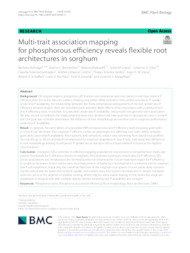Multi-trait association mapping for phosphorous efficiency reveals flexible root architectures in sorghum.
Multi-trait association mapping for phosphorous efficiency reveals flexible root architectures in sorghum.
Author(s): HUFNAGEL, B.; BERNARDINO, K. C.; MALOSETTI, M.; SOUSA, S. M. de; SILVA, L. A.; GUIMARÃES, C. T.; COELHO, A. M.; SANTOS, T. T.; VIANA, J. H. M.; SCHAFFERT, R. E.; KOCHIAN, L. V.; EEUWIJK, F. A.; MAGALHAES, J. V. de
Summary: Abstract. Background. On tropical regions, phosphorus (P) fxation onto aluminum and iron oxides in soil clays restricts P difusion from the soil to the root surface, limiting crop yields. While increased root surface area favors P uptake under low-P availability, the relationship between the three-dimensional arrangement of the root system and P efciency remains elusive. Here, we simultaneously assessed allelic efects of loci associated with a variety of root and P efciency traits, in addition to grain yield under low-P availability, using multi-trait genome-wide association. We also set out to establish the relationship between root architectural traits assessed in hydroponics and in a low-P soil. Our goal was to better understand the infuence of root morphology and architecture in sorghum performance under low-P availability. Result In general, the same alleles of associated SNPs increased root and P efciency traits including grain yield in a low-P soil. We found that sorghum P efciency relies on pleiotropic loci afecting root traits, which enhance grain yield under low-P availability. Root systems with enhanced surface area stemming from lateral root proliferation mostly up to 40 cm soil depth are important for sorghum adaptation to low-P soils, indicating that diferences in root morphology leading to enhanced P uptake occur exactly in the soil layer where P is found at the highest concentration. Conclusion. Integrated QTLs detected in diferent mapping populations now provide a comprehensive molecular genetic framework for P efciency studies in sorghum. This indicated extensive conservation of P efciency QTL across populations and emphasized the terminal portion of chromosome 3 as an important region for P efciency in sorghum. Increases in root surface area via enhancement of lateral root development is a relevant trait for sorghum low-P soil adaptation, impacting the overall architecture of the sorghum root system. In turn, particularly concerning the critical trait for water and nutrient uptake, root surface area, root system development in deeper soil layers does not occur at the expense of shallow rooting, which may be a key reason leading to the distinctive sorghum adaptation to tropical soils with multiple abiotic stresses including low P availability and drought.
Publication year: 2024
Types of publication: Journal article
Unit: Embrapa Maize & Sorghum
Keywords: Arquitetura radicular, Eficiência de aquisição de fósforo, Estresse de fósforo, Estudos de associação genômica ampla, Genome Wide Association Studies, Loci de característica quantitativa, Morfologia radicular, Phosphorus, Phosphorus acquisition efficiency, Phosphorus stress, Polimorfismos de nucleotídeo único, Quantitative trait loci, Root architecture, Root morphology, Single nucleotide polymorphism, Sorgo
Observation
Some of Embrapa's publications are published as ePub files. To read them, use or download one of the following free software options to your computer or mobile device. Android: Google Play Books; IOS: iBooks; Windows and Linux: Calibre.
Access other publications
Access the Agricultural Research Database (BDPA) to consult Embrapa's full library collection and records.
Visit Embrapa Bookstore to purchase books and other publications sold by Embrapa.

